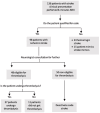The Necessity of Using MRI as an Imaging Modality in Acute Code Stroke in Indonesia
- PMID: 40207027
- PMCID: PMC11980791
- DOI: 10.2147/VHRM.S503362
The Necessity of Using MRI as an Imaging Modality in Acute Code Stroke in Indonesia
Abstract
Purpose: To evaluate the performance and outcomes of the 6-minute magnetic resonance imaging (MRI) protocol in diagnosing stroke within Indonesian healthcare setting compared to computed tomography (CT).
Patients and methods: This retrospective single-center study was conducted at the Universitas Indonesia Hospital in Depok, Indonesia from September 2021 to September 2023. Patients who were diagnosed with acute stroke underwent a clinical evaluation and a 6-minute MRI protocol. The primary objective was to assess the efficiency of the 6-minute MRI protocol in promptly and accurately evaluating acute stroke patients, including determining average MRI time, thrombolysis eligibility, and post-thrombolysis outcomes compared to CT imaging. Exclusions comprised those requiring resuscitation, lack of stroke code activation, or having incomplete documentation.
Results: This study involved 182 stroke patients, 136 of which underwent MRI and 46 had CT scans. Thrombolysis eligibility was similar between the groups (48.9% for MRI vs 47.8% for CT-Scan), but a higher proportion of eligible MRI patients received thrombolysis (70.1% vs 54.5%, p = 0.037). MRI also achieved shorter door-to-imaging times, especially from February to June 2022. Among those treated for ischemic stroke via MRI, 70.3% showed improvement compared to 55% for CT (p=0.016). Door-to-MRI times varied across periods, averaging 88.2 minutes before national healthcare insurance collaboration, 29.1 minutes during transition, and 47.8 minutes afterward.
Conclusion: This study emphasizes the crucial role of the 6-minute MRI protocol for accurately diagnosing stroke types, severity, and determining thrombolysis eligibility. Positive outcomes in thrombolysis patients using this protocol highlight its effectiveness. However, prolonged time-to-MRI indicates the need for further improvement. Optimizing time management and workflow efficiency are critical for improving treatment efficacy and safety.
Keywords: CT-scan; MRI; code stroke; developing country; thrombolysis.
© 2025 Hidayat et al.
Conflict of interest statement
The authors report no conflicts of interest in this work.
Figures
References
-
- Pu L, Wang L, Zhang R, Zhao T, Jiang Y, Han L. Projected global trends in ischemic stroke incidence. Deaths Disability-Adjusted Life. 2023;(May):1330–1339. - PubMed
-
- Kesehatan K. Badan penelitian dan pengembangan kesehatan kementerian RI tahun. 2018. riset kesehatan dasar (Riskesdas) 2018. J Food Nutr Res. 2014;2(12):1029–1036. Indonesian.
-
- Campbell BCV, Ma H, Ringleb PA, et al. Extending thrombolysis to 4·5–9 h and wake-up stroke using perfusion imaging: a systematic review and meta-analysis of individual patient data. Lancet. 2019;394(10193):139–147. - PubMed
-
- Wahlgren N, Ahmed N, Dávalos A, et al. Thrombolysis with alteplase for acute ischaemic stroke in the safe implementation of thrombolysis in stroke-monitoring study (SITS-MOST): an observational study. Lancet. 2007;369(9558):275–282. - PubMed
Publication types
MeSH terms
LinkOut - more resources
Full Text Sources
Medical


